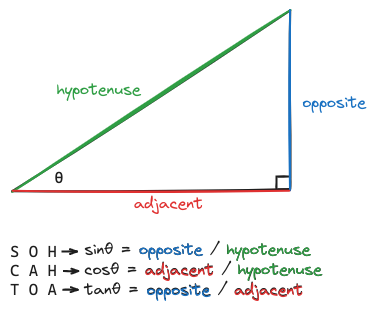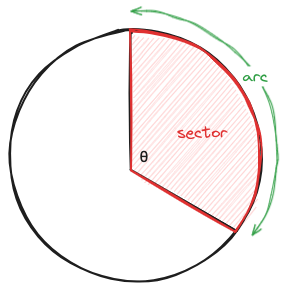SAT(R) Math Cheat Sheet
Numbers & Arithmetic
Percents
To get the percent of a value:
where is the starting amount, is the percent expressed as a decimal, and is the final result.
To calculate a percentage increase or decrease:
where is the starting amount, is the percent change expressed as a multiplier, and is the final result.
To convert a percentage change into a multiplier:
| % Change | Calculation | Multiplier | |
|---|---|---|---|
| formula | |||
| increase | |||
| increase | |||
| increase | |||
| increase | |||
| decrease | |||
| decrease |
To convert a multiplier into a percentage change:
| Multiplier | Calculation | % Change | |
|---|---|---|---|
| formula | |||
| increase | |||
| increase | |||
| increase | |||
| increase | |||
| decrease | |||
| decrease |
Fractions
Cross multiplication:
Dividing by a fraction:
Linear Functions
Slope formula
Given two points, and , the slope of a linear equation is:
Slope-intercept Form
Given an equation in the form :
- the slope of the line is
- the slope of the perpendicular line is
- the -intercept is
- the -intercept is
Standard Form
Given an equation in the form :
- the -intercept is
- the -intercept is
- the slope of the line is
- the slope of the perpendicular line is
Quadratic Functions
General Form
Given a quadratic function in the form :
- the axis of symmetry is at
- the vertex is at
- the sum of the solutions is
- the product of the solutions is
- the solutions, if they exist, are
- To determine how many solutions a quadratic has:
=> Two solutions
=> One solution
=> No solutions
- To determine the distance between the solutions:
-intercept Form
Given a quadratic function in the form :
- the solutions are
- the axis of symmetry is
- the coordinates of the vertex are
- the product of solutions is
- the sum of solutions is
Vertex Form
Given a quadratic function in the form :
- the coordinates of the vertex are
- the axis of symmetry is
- the solutions, if they exist, are
- if , the quadratic has 1 solution
- if , then the quadratic has two solutions
- if , then the quadratic has no solutions
- the product of solutions is
- the sum of solutions is
- the distance between the solutions is
Exponential Functions
Given an exponential function in the form :
- the -intercept is
- the growth rate is , expressed as a multiplier
- if , then the function is decreasing.
- if , then the function is increasing.
- is how many times the function increases or decreases per step in the .
Stats & Probability
Mean
- the mean is the simple or weighted average of a set of numbers:
Where is the value of each item and is the amount of times the item appears (the frequency).
For example, if , then the mean is:
Mode
Given a set of numbers, the mode is the number that appears most frequently:
For example, if , then the mode of set is .
Median
Given a set of ordered numbers, the median is the middle number:
For example, if , then the median of set is .
Standard Deviation
Given a set of numbers, the standard deviation tells us how spread out the data are. For example, for these two data sets:
Both are more or less centered around but set has a larger standard deviation because the numbers are more spread out.
You shouldn't ever need to calculate the standard deviation, but you should be able to tell whether one data set has a higher standard deviation than the other.
Geometry & Trigonometry
SOHCAHTOA
SOHCAHTOA is pretty much all you need on the SAT for trig problems.

From these relationships, we can also determine that:
which is equivalent to:
30-60-90 Triangle
Any triangle whose angles are 30°, 60°, and 90° will have side lengths in the following ratios:
| shortest side | middle side | hypotenuse | |
|---|---|---|---|
| general case | |||
| example 1 | |||
| example 2 |
45-45-90 Triangle
Any triangle whose angles are 45°, 45°, and 90° will have side lengths in the following ratios:
| shortest side | hypotenuse | |
|---|---|---|
| general case | ||
| example 1 | ||
| example 2 |
Pythagorean Triples
Any triangle whose side lengths are in the following ratios will be right angled triangles:
| side A | side B | side C | note |
|---|---|---|---|
| 3 | 4 | 5 | super common |
| 5 | 12 | 13 | uncommon |
| 8 | 15 | 17 | super rare |
Circle Arcs and Sectors
Given a slice of a circle, like so:

We can say that: